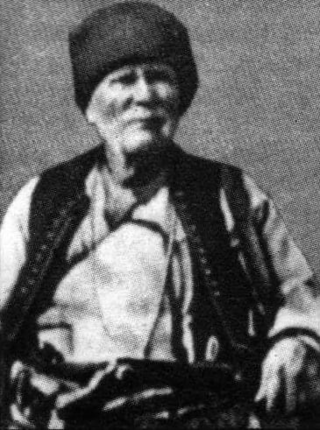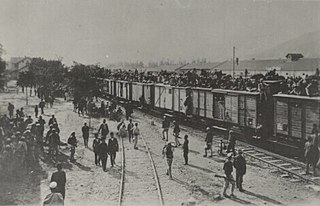Ottoman Albania refers to a period in Albanian history from the Ottoman conquest in the late 14th century to the Albanian declaration of Independence and official secession from the Ottoman Empire in 1912. The Ottomans first entered Albania in 1385 upon the invitation of the Albanian noble Karl Thopia to suppress the forces of the Serbian noble Balša II during the battle of Savra. They had some previous influence in some Albanian regions after the battle of Savra in 1385 but not direct control. The Ottomans placed garrisons throughout southern Albania by 1420s and established formal jurisdiction in central Albania by 1431. Even though The Ottomans claimed rule of all Albanian lands, most Albanian ethnic territories were still governed by medieval Albanian nobility who were free of Ottoman rule. The Sanjak of Albania was established in 1420 or 1430 controlling mostly central Albania, while Ottoman rule became more consolidated in 1481, after the fall of Shkodra and League of Lezhe with the country being mostly free in the period of 1443-1481. Christian Albanians revolted again in 1481 but the Ottomans finally controlled Albania by 1488.

Mirdita is a region of northern Albania whose territory is synonymous with the historic Albanian tribe of the same name.

Ali Pasha Shabanagaj, was an Albanian Muslim military commander and one of the leaders of the League of Prizren. He governed, as an Ottoman kaymakam (sub-governor), an area in what is today eastern Montenegro around Plav and Gusinje. He was commonly known as Ali Pasha of Gusinje. He was the leader of the Albanian irregular troops of the League of Prizren against the Principality of Montenegro at the Battle of Novšiće. He was governor of the area of Plav and Gusinje located in a valley between steep mountains.

Idriz Seferi was an Albanian leader and guerrilla fighter (rebel). During his 56 year military career, he fought in 35 battles. A member of the League of Prizren and League of Peja, he was the right-hand man of Isa Boletini, with whom he organized the 1910 Uprising against the Ottoman Empire in the Kosovo Vilayet. After the suppression of the uprising, Seferi continued warfare, in the 1912 Uprising. In the First Balkan War, Boletini and Seferi rose up against Serbia, with whom they had previously been allies to during the 1910 and 1912 Uprisings, and continued to attack Serbian posts in the subsequent occupation and initial phase of World War I (1913-1915). In the second phase of the war (1916-1918), he led troops against Bulgarian forces.
The Albanian Revolt of 1843–1844, variously also known as the Revolt of 1844 or the Uprising of Dervish Cara, was a 19th-century uprising in northern Ottoman Albania directed against the Ottoman Tanzimat reforms which started in 1839 and were gradually being put in action in the regions of Albania. Some historians include the actions in Dibër of the same time under the same historical name, though the events in Dibër were independent and headed by other leaders.
Mic Sokoli was an Albanian nationalist figure and guerrilla fighter from the Highlands of Gjakova. He was a noted guerrilla leader during the years of the League of Prizren and took part in the fighting in Gjakova against Mehmet Ali Pasha. He fought in the Battle of Nokshiq against the Montenegrins. He is remembered by Albanians for an act of heroism in April 1881, in which he sacrificed himself by pressing his body against the mouth of an Ottoman cannon.

The Albanian revolt of 1912, also known as the Albanian War of Independence, was the last revolt against the Ottoman Empire's rule in Albania and lasted from January until August 1912. The revolt ended when the Ottoman government agreed to fulfill the rebels' demands on 4 September 1912. Generally, Muslim Albanians fought against the Ottomans in the incoming Balkan War.

The Albanian Vilayet was a projected vilayet of the Ottoman Empire in the western Balkan Peninsula, which was to include the four Ottoman vilayets with substantial ethnic Albanian populations: Kosovo Vilayet, Scutari Vilayet, Manastir Vilayet, and Janina Vilayet. In some proposals, it included the Salonica Vilayet as well. The creation of the Vilayet was confirmed in September 1912, but negotiations were interrupted a month later in October by the beginning of the First Balkan War. Plans for an Albanian Vilayet were lost with the Partition of Albania.

Prenk Bib Doda, also known as Prênk Pasha, was an Albanian member of the Young Turks, prince of Mirdita, and politician in the Principality of Albania.

The Peasant Revolt in Albania, also known as the Islamic Revolt or Muslim Uprising in Albania, was an uprising of peasants from central Albania, mostly Muslims against the regime of Prince Wilhelm of Wied during 1914. It was one of the reasons for the prince's withdrawal from the country which marked the fall of the Principality of Albania. The uprising was led by Muslim leaders Haxhi Qamili, Arif Hiqmeti, Musa Qazimi and Mustafa Ndroqi. Along with a demand of total amnesty, the rebels required the return of Albania to the suzerainty of the Sultan of the Ottoman Empire.

The International Gendarmerie was the first law enforcement agency of the Principality of Albania. It was established by the decision of the ambassadors of the six Great Powers that participated in the London Peace Conference. This decision was made on the basis of the London Treaty signed on May 30, 1913. Since most of the members were from the Netherlands, this force was also known as the Dutch Military Mission.

The Albanian revolt of 1911 or the Malësori uprising of 1911 was one of many Albanian revolts in the Ottoman Empire and lasted from 24 March 1911 until 4 August 1911 in the region of Malësia.

Gashi is an Albanian surname and the name of one of the major historical tribes of northern Albania. It is a historical tribal region situated in the Highlands of Gjakova. The Gashi tribe is known to follow the Kanuni i Malësisë së Madhë, a variant of the Kanun. They were known among the mountain tribes for their wisdom.

Bib Doda Pasha (1820–1868) was the ruler of Mirdita. He held the Ottoman rank of kapedan (captain) and the honorific pasha (governor).

Binak Alia (1805–1895) was an Albanian leader from the Highlands of Gjakova. He is remembered mainly for his participation in the Albanian Revolt of 1845, and as a wise old man who helped resolve blood feuds in the area.

Shoshi is a historical Albanian tribe (fis) and region of northern Albania in the lower Shala valley. Shoshi is first recorded as a small settlement in 1485. The fis itself traces its origin to the brothers Gjol and Pep Suma. The community of their descendants gradually grew to control part of the Dukagjin highlands. In the 19th century Shoshi also became a bajrak.
Dah Polloshka or Abdullah Polloshka (1800-1845) was an Albanian warrior from Gjakova who fought Ottoman Tanzimat-reforms. He fell in the Albanian revolt of 1845 fighting the Ottomans in Nakarade, Gjakova. The Polloshka family, alongside the Vula family, were the founding families of Gjakova. Polloshka family derives from the Krasniqi and Geghyseni. Polloshka's house was burned twice by the Ottomans.

The Highlands of Gjakova or Gjakova Highlands refers to the mountainous ethnographic region in the eastern Albanian Alps that sits between north-eastern Albania and western Kosovo, serving as the historical centres of the Albanian Gashi, Krasniqi, Bytyqi, Morina, Nikaj and Mërturi tribes. Traditionally, parts of the Gjakova Highlands that are now located in southern Montenegro were used as pasturelands by the local Albanian tribes.
The Battle of Carraleva Pass was a battle between Albanian rebels and Ottoman forces during the Revolt of 1910. The clash represented a military offensive launched by Shevket Turgut Pasha against Albanian rebels that were blocking the Carraleva Pass. After 3 Days of fighting the Albanian insurgents were defeated and retreated to the Drenica region.
The Taksim meeting alternatively known as the Taksim Plot and less commonly as the Taksim Assembly was a secret meeting held in January 1912 by Albanian nationalist deputies of the Ottoman parliament and other prominent Albanian political figures. The event gets its name from Taksim Square because of the location of the house where it was held. The meeting was organized on the initiative of Hasan Prishtina and Ismail Qemali, Albanian politicians, who invited most of the MPs of Albanian origin and aimed at launching an armed general uprising in Albanian territories against the central government headed by the Committee of Union and Progress (CUP). The meeting followed two other Albanian uprisings of 1910 in the Vilayet of Kosovo and 1911 in the mountains of upper Shkodra. The Taksim meeting resulted in an uprising the same year, with armed uprisings in Shkodër, Lezhë, Mirditë, Krujë and other Albanian provinces, which exceeded the organizers' expectations. The biggest uprising was in Kosovo, where the rebels were more organized and managed to take over important cities like Prizren, Peja, Gjakova, Mitrovica and others.












